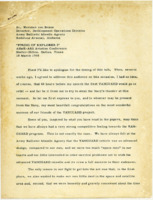
Ernst Geissler Collection
Dublin Core
Identifier
Ernst Geissler Collection
Title
Ernst Geissler Collection
Description
Ernst D. Geissler was born on August 4, 1915 in Chemnitz, Saxony, Germany, where he attended grammar school and high school until 1934. From there, he left to attend a technical university in Dresden, Germany, where he graduated with a diploma in Technical Physics. After graduating, he went to work with the Von Braun missile team, where he eventually patented new steering methods for guided missiles and homing devices against aircraft.
On November 16, 1945, Geissler and his wife, Gerda K. Stricker, immigrated to the United States. Geissler began to work with the U.S. Army in Fort Bliss, Texas as a group leader for flight mechanics and aerodynamics on the Hermes II missile. After five years, Geissler went on to work for Redstone Arsenal as the Director of the Aeroballistics Laboratory in charge of theoretical and experimental aerodynamics and flight mechanics. While there, Geissler helped develop the Explorer I satellite and the Pioneer V space probe, and the Redstone, Jupiter, and Pershing missiles. He also developed patents for an aerodynamically stabilized missile and an artificially stabilized missile.
In 1960, Geissler left Redstone and joined the George C. Marshall Space Flight Center of NASA. He worked as the Director of the Aerodynamics and Astrodynamics Laboratory, working on the Saturn I - Saturn V family and space shuttle development. In 1973, Ernst Geissler retired from NASA and eventually passed away on June 3, 1989.
On November 16, 1945, Geissler and his wife, Gerda K. Stricker, immigrated to the United States. Geissler began to work with the U.S. Army in Fort Bliss, Texas as a group leader for flight mechanics and aerodynamics on the Hermes II missile. After five years, Geissler went on to work for Redstone Arsenal as the Director of the Aeroballistics Laboratory in charge of theoretical and experimental aerodynamics and flight mechanics. While there, Geissler helped develop the Explorer I satellite and the Pioneer V space probe, and the Redstone, Jupiter, and Pershing missiles. He also developed patents for an aerodynamically stabilized missile and an artificially stabilized missile.
In 1960, Geissler left Redstone and joined the George C. Marshall Space Flight Center of NASA. He worked as the Director of the Aerodynamics and Astrodynamics Laboratory, working on the Saturn I - Saturn V family and space shuttle development. In 1973, Ernst Geissler retired from NASA and eventually passed away on June 3, 1989.
Collection Tree
- Space Collections
- Ernst Geissler Collection
